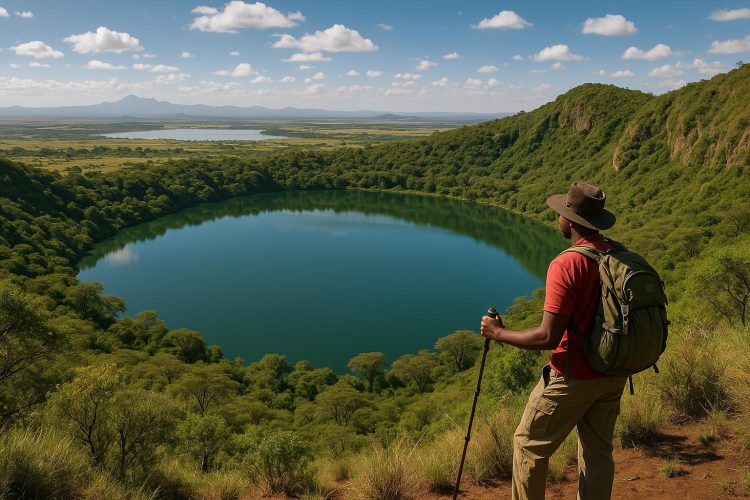Lake Elementaita is a small crater lake located in Kenya, within the Great Rift Valley, a region known for its geological significance and rich biodiversity. This feature serves as one of the main attractions in the landscape of Kenya, bringing attention to its unique ecological environment and the plethora of wildlife it supports.
The Geographical Context
Situated at an altitude of about 1,670 meters above sea level, Lake Elementaita occupies an area of approximately 18 square kilometers. The lake’s location at this elevation contributes to its distinct climate and environmental conditions. Because of its classification as a soda lake, Lake Elementaita is characterized by its alkaline water predominantly fed by hot springs situated at its southern end. This natural phenomenon occurs due to the high levels of dissolved alkaline salts in the water.
The region where Lake Elementaita is located experiences a semi-arid climate, with seasons alternating between wet and dry periods. This climate patterns create a stark contrast between the lushness of the wet season and the aridness of the dry months. Despite this, Lake Elementaita manages to maintain its role as a crucial ecological zone within this relatively dry terrain.
Ecological Significance
The unique chemistry of Lake Elementaita, specifically its alkaline waters, plays a vital role in supporting a variety of life forms. Recognized as a Ramsar Site, the lake highlights its importance as a wetland ecosystem of international significance. This designation serves to emphasize the ecological value and the necessity of conserving this delicate environment.
The lake acts as a crucial habitat for numerous bird species, some of which are in danger of extinction. Among the most notable are the endangered lesser flamingos and the great white pelicans. The thriving populations of these birds can largely be attributed to the plentiful supply of algae and plankton that flourish in the lake’s alkaline waters. These organisms form the primary food source for the birds, supporting this vibrant avian community.
Biodiversity and Conservation
Beyond avian life, the areas surrounding Lake Elementaita boast a remarkable biodiversity. The lake adjoins the Soysambu Conservancy, a protected area that ensures the sustainability of local wildlife and their habitats. The conservancy plays an instrumental role in maintaining the delicate ecological balance necessary for the survival of numerous species.
Efforts to conserve Lake Elementaita focus on addressing various challenges from both climate change and human activities. Human intervention in the form of agriculture and urban development poses a significant threat to the ecological integrity of this area. Climate change, with unpredictable rainfall patterns and rising temperatures, further complicates these conservation efforts.
Exploration Opportunities
Lake Elementaita offers visitors an array of opportunities to explore its natural beauty and learn more about its unique ecosystem. Guided tours around the lake and its surroundings are designed to emphasize ecological education and the significance of conservation. These tours provide insights into the ongoing efforts to preserve this vital habitat.
Popular activities for tourists include bird watching, a favorite among nature enthusiasts who come to observe the rich array of bird species that inhabit the lake. Nature walks also allow visitors to take in the scenery and appreciate the stunning landscape shaped by geological forces over millennia. The site’s geological features, such as volcanic hills and hot springs, offer additional points of interest, providing a captivating backdrop to the natural wonders of Lake Elementaita.
Further Reading and Resources
For those interested in learning more about the significance of Lake Elementaita and the efforts being made to conserve its unique environment, numerous resources are available. Exploring reputable sources, such as international conservation organizations, can provide a wealth of information on the ecological and geological aspects of the lake. Scientific publications focused on ecology and geology offer in-depth insights into the challenges faced by this ecosystem and the strategies employed in its preservation.
Online resources, like the websites of local conservation groups, frequently provide valuable updates on ongoing efforts to protect Lake Elementaita. These organizations often publish findings from research conducted in the area, sharing experiences, successes, and challenges in the mission to conserve this critical ecosystem. Exploring these platforms can offer comprehensive perspectives on both the global and local efforts dedicated to preserving Lake Elementaita’s natural heritage.
Engaging with these resources can deepen understanding of the complex interactions between climate, geology, and biodiversity that characterize this unique region. By participating in conservation efforts or supporting organizations working for the health of Lake Elementaita, individuals can contribute to the ongoing stewardship of this important ecological treasure. Whether through active involvement or awareness-raising, every effort counts towards ensuring the sustained vitality of Lake Elementaita and its surrounding landscape for future generations.
